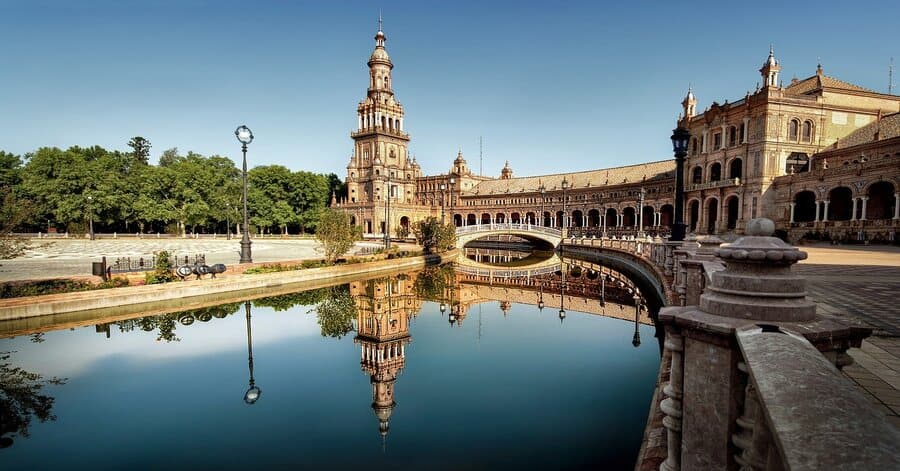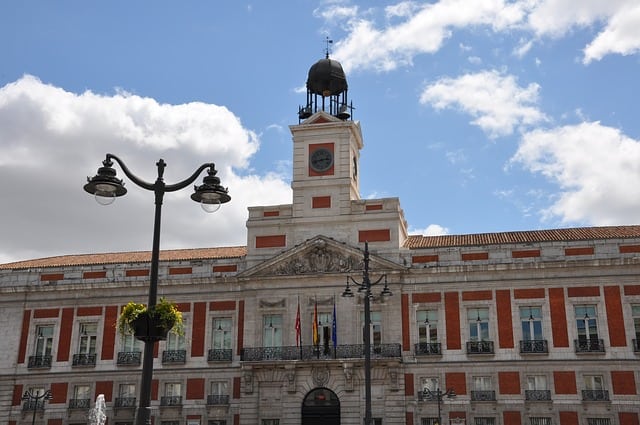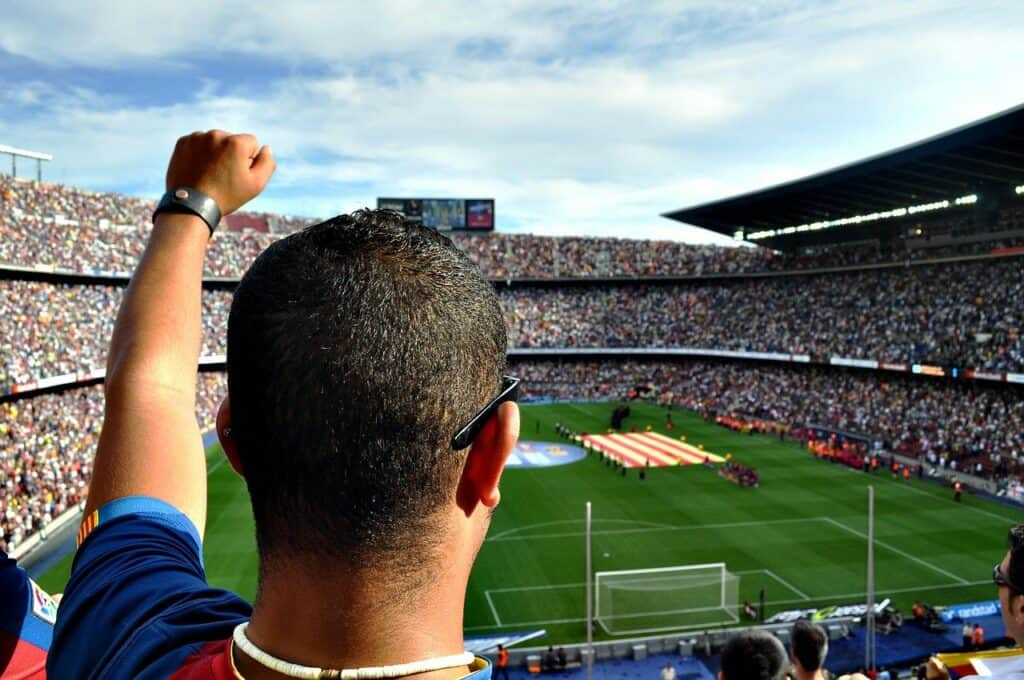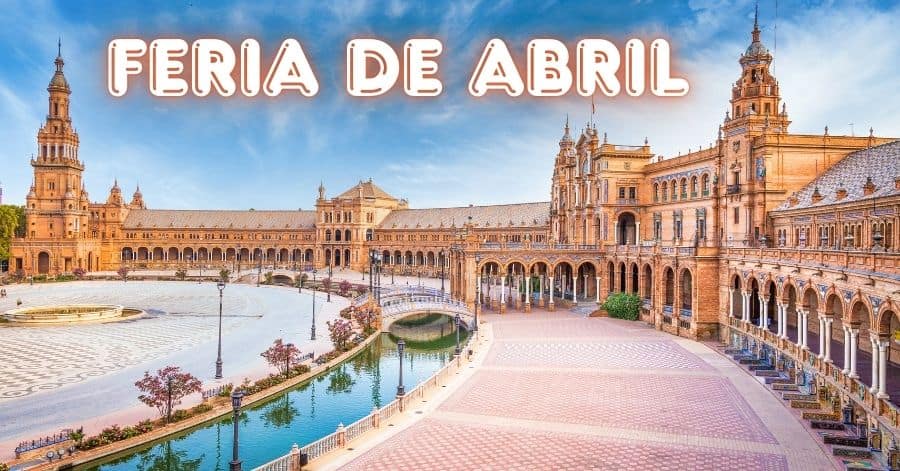Madrid is the capital of Spain and the most populous city in the country with 3.3 million inhabitants. The Madrid Metropolitan Area together makes up for 6.5 million of Spain’s 47 million inhabitants. It used to be the seat of the Spanish government. Today, it is the residential city of the Spanish royal family; Madrid is Spain’s economical, political, and cultural center. As such, there are many things to do and see on your journey through the city.
Barcelona is Spain’s second most populated (and famous) city.
Exciting Must See Attractions in Madrid
River Manzanares
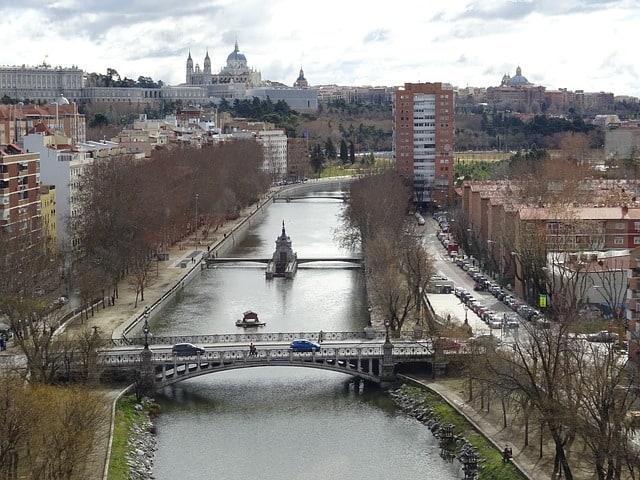
The River Manzanares runs from the Sierra de Guadarrama to the Jarama river, passing through the city of Madrid. Nowadays, the river is unimportant, but in the past, it held a great amount of significance. As it lies close to a former Moor citadel, the river was their main source of water. Aside from the city of Madrid, the river also passes through a medieval town called Manzanares el Real. There, the manmade dam gave rise to the Santillana reservoir. To Madrid, the reservoir is a very important body of water.
Palacio Real (The Royal Palace)
If you didn’t already know, Spain is a country with a monarchy. Palacio Real, or The Royal Palace, is the official residence of the current royal family. With 135,000 square meters of floor space and 3,418 rooms, The Royal Palace in Madrid is the largest functioning royal residence in the world. During the day, certain areas of the palace are open to the public for a low fee of €4 (USD$4.89)
There are nine areas of the palace that are viewable by the public.
Plaza de la Armería
The originals plans of the Plaza de la Armería were laid-out in 1892. The story behind the structure, however, dates all the way back to 1553. In 1553, the ruling monarch Philip II ordered a building to be erected and used to house the royal stables.
The Plaza de la Armería is a square that has The Royal Palace as one of its focal sites. Another such building is The Almudena Cathedral, which faces The Royal Palace across the plaza. Prince Alfonso supposedly had it commissioned as a memorial to his wife. The church’s construction span a whole century, having started in 1878 and finished in 1992.
Plaza de Oriente
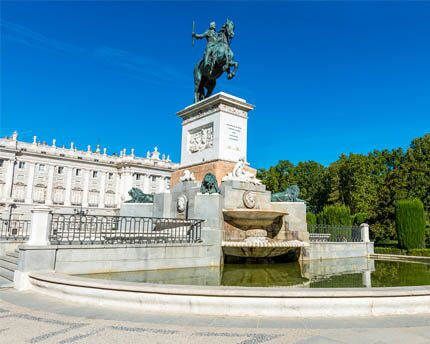
The Plaza de Oriente is a rectangular park on the Royal Palace’s east side. After Joseph Bonaparte ordered the demolition of 60 medieval structures, he started the construction of the park. However, he was deposed before the park came to completion. Queen Isabella II tasks architect Narciso Pascual Colomer to finish the park.
The Plaza de Oriente is divided into three distinct parts: the Central Gardens, the Cabo Noval Gardens, and the Lepanto Gardens. Visitors are greeted by several flowerbeds and statues of historically significant figures.
Campo del Moro Gardens
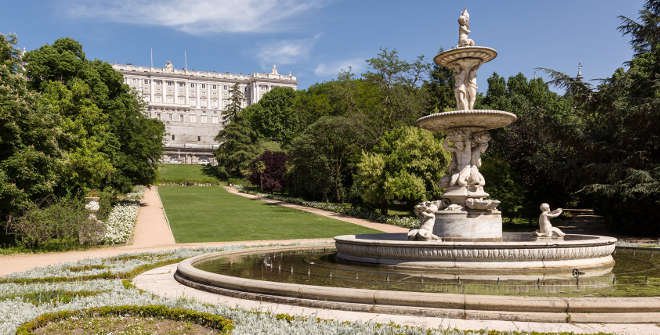
The name of the gardens alludes to history. Meaning “The Moor Camp” in English, the name brings to mind a dark time for Madrid; the garden served Muslim leader Ali ben Yusuf during his attempted reconquest of Madrid. Quickly after, King Philip IV improved upon the gardens, building fountains and planting a variety of vegetation.
The Campo del Moro Gardens were based on the gardens of the Royal Palace of La Granja de San Ildefonso. However, the gardens held a distinct romantic style, reflecting the times in which they were first built.
Sabatini Gardens
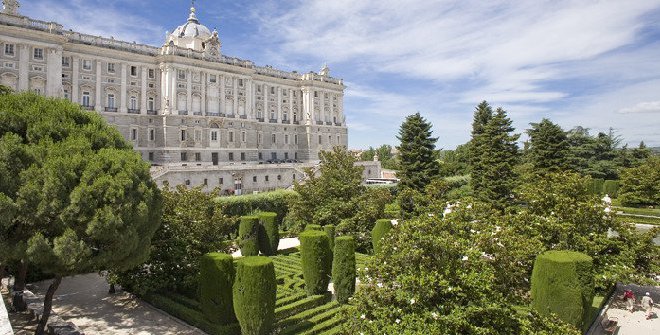
The last of the outdoor sites of The Royal Palace is the Sabatini Gardens, dedicated to Italian architect Francesco Sabatini. In 1978, Spanish monarch King Juan Carlos opened these gardens to the public; locals and tourists can visit and admire the beauty of these gardens.
Grand Staircase
The ever-prolific architect Francesco Sabatini built the Grand Staircase originally in 1760. But in 1789, when King Charles IV wanted it on the opposite side of the palace, he built another one. This new one is in the palace today. The Grand Staircase obviously is the focal point of the palace, and it draws the attention of visitors. At the landing of the staircase, there are two lion statues to greet you. These lion statues are by Felipe de Castro and Robert Michael. As you walk up the staircase, you can view the fresco Religion Protected by Span, which is by Corrado Giaquinto.
Royal Library
The Royal Library used to be on an upper floor, but during Maria Christina’s regency, it was moved to a lower floor. There are many books in the Royal Library that date back to the reigns of Isabelle II, Charles III, and Alfonso XII. Highlights include the Book of Hours by Isabella I of Castille, a codex of the time by Alfonso XI of Castille, a Bible by Doña Maria de Molina, and the Festas reales, written by Farinelli and dedicated to Ferdinand VI. When looking through the Royal Library, visitors can observe the evolution of bookbinding techniques and styles. For example, they can see books with binds in the Rococo and Neoclassical styles.
Royal Pharmacy
The Royal Palace saw the addition of the Royal Pharmacy during the reign of King Felipe II. The royal family at the time then started to regularly order medical supplies. This role of the royal family and staff has continued since. Nowadays, the current royal household still orders its supply of medicines and medical aids.
Royal Armory
The Royal Armory, a part of the Royal Palace, is considered one of the two best collections of armory and weapons in the world. The other best armory is the Royal Armory in Vienna. Visitors can view various pieces of personal armor and weapons used over the course of Spanish history, including ones used by Holy Roman Empire Charles V and Philip II. They can also catch a glimpse of diplomatic works of art, including maps and tapestries.
King Charles II Apartments
As the name suggests, this area of the Royal Palace was used chiefly by King Charles II. It consists of four main rooms. The Halberdier’s room, or the Guard Room, showcases the fresco by Piepolo, Venus, and Vulcan, along with two paintings depicting science from the life of Solomon by Luca Giordano.
The Hall of Columns is one of the hallways of the palace, and has a ceiling fresco by Giaquinto, representing The Sun before Which All the Forces of Nature Awaken and Rejoice, an allegory of the king as Apollo. At one end of the hall stands an 1878 bronze statue of Charles V Vanquishing Fury by Ferdinand Barbedienne. The lighting chandeliers were designed and built-in Paris, France.
The Throne Room dates back to the reign of Charles III and features Tiepolo’s ceiling fresco, The Apotheosis of the Spanish Monarchy. Around the room are bronze sculptures, including the Four Cardinal Virtues, four of the Seven Planets, Satyr, Germanicus, and four Medici lions defending the throne.
Charles III’s Anteroom, or the Saleta, has the 1774 ceiling fresco Apotheosis of Trajan by A.R. Mengs. The Antechamber of Charles III, or The Conversation Room, also contains a ceiling fresco by Mengs, The Apotheosis of Hercules. The famous Spanish painter Francisco Goya has also contributed to the design of The Conversation Room with his four portraits of different members of the royal family.
The Queen’s Apartments and Banqueting Hall
During King Charles III’s reign, these three rooms were aptly named the Queen’s Apartments. However, in 1885, King Alfonso XII ordered the transformation of the rooms into a combined banquet hall. The ceiling frescos that decorated the Queen’s Apartments still remain, however. These paintings are Dawn in Her Chariot by Raphael Mengs, Christopher Columbus Offering the New World to the Catholic Monarchs by Alejandro Gonzalez Velazquez, and Boabdil Giving the Keys to Granada to the Catholic Monarchs by Francisco Bayeu y Subías.
Apartments of Infante Luis
These rooms called The Apartments of Infante Luis were used by none other than Infante Luis, Count of Chinchón, the youngest person to ever become Cardinal. Before his exile, he used these rooms when staying at the Royal Palace. Now, the Apartments of Infante Luis is known as the Stradivarius Room and now has a viola, two violoncellos, and two violins made by Stradivari.
Rooms in the Stradivarius Room now contain a viola, two violoncellos, and two violins by Stradivari. The ceiling fresco by A. G. Velazquez depicts Gentleness accompanied by the Four Cardinal Virtues.[41]
The Chamber of the Infante Luis, Musical Instruments Room, has a ceiling fresco by Francisco Bayeu depicting Providence Presiding over the Virtues and Faculties of Man.
Royal Chapel
Spain has always been a Roman Catholic country and of course, the royal family has built a chapel as part of the Royal Palace. Its construction was finalized in 1748 by architects Sacchetti and Ventura Rodríguez. Visitors to the chapel will be graced with the ceiling frescoes by Giaquinto, including The Trinity, Allegory of Religion, Glory, and the Holy Trinity Crowning the Virgin.
The Crown Hall
Formerly the living quarters of Maria Christina of Austria, the mother of King Alfonso XIII, the Crown Hall today has the throne, scepter, and crown of King Charles III.
Plaza Mayor
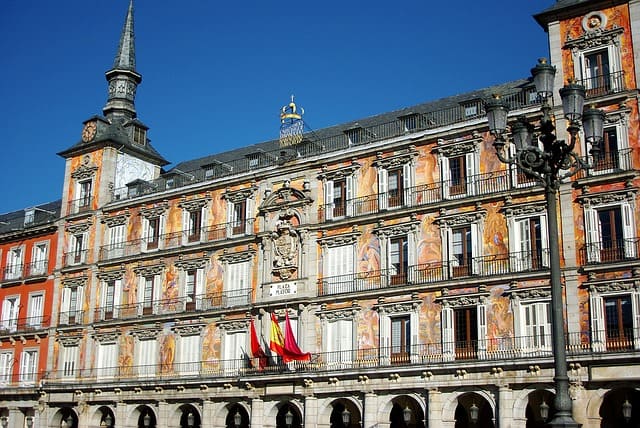
Plaza Mayor, at the heart of Madrid, is one of the main plazas or squares in the city. The other main plaza is mere minutes away from Plaza Mayor. It is indeed the heart of the city because from here, tourists and locals have access to nearby restaurants, cafes, pubs, museums, and shopping centers. The Plaza Mayor is a great place to visit and traverse through in the day or in the night. At night, the place has a romantic atmosphere with all the lights are on.
Plaza de Cibeles
Named for the Cibeles Palace and the Cibeles fountain that both stand in the plaza, the Plaza Cibeles serves as an iconic tourist attraction as well as a symbol of the city. The Cibeles Palace, or the Cybele Palace, used to be Madrid’s Council of Communications and the main headquarters for all mail, telephone, and telegram transfers over the course of history.
In front of the palace, there is the Cybele Fountain, which has a statue of the Greek goddess Cybele or Phrygia, the ancient goddess of healing, fertility, and protection during wartime. It’s no wonder, then, that the wartime patroness should be the goddess that symbolizes the city of Madrid.
Gateway of the Sun (Puerta del Sol)
Besides the Plaza Mayor, the Gateway of the Sun (Puerta del Sol in Spanish) is the other main central square in Madrid. Like the Plaza Mayor, the Puerta del Sol Square attracts visitors every day from morning to night, since from the square, the rest of the city’s attractions are easily accessible by public transport. A famous landmark that you can see at the plaza is the clock whose bells have marked the beginning of the new year and the eating of the Twelve Grapes since 1962.
Buen Retiro Park (Parque del Buen Retiro)
Madrid has a lot of green sceneries, and Buen Retiro Park is a shining example of a collection of Spain’s nature. Covering 125 hectares of ground and with over 15,000 trees, Buen Retiro Park branches into smaller areas with their own distinct beauty. These areas include Jardín de Vivaces, the Jardines de Cecilio Rodríguez, the Jardines del Arquitecto Herrero Palacios, the Rosaleda Rose Garden, and the Parterre Francés. The last of these showcases a Mexican conifer that is nearly 400 years old and believed to be the oldest tree in all of Madrid.
The Neighborhood of Salamanca
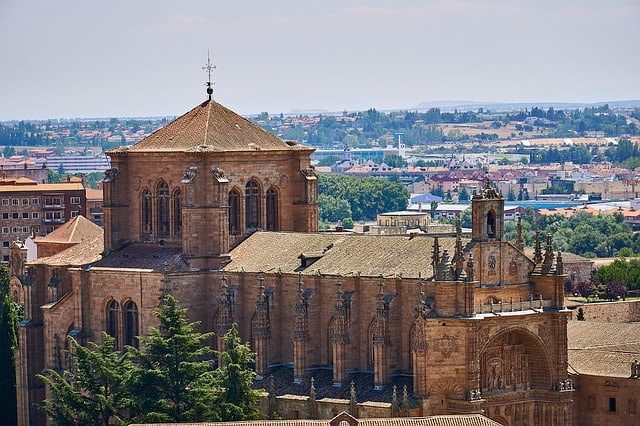
Perhaps you want to take a stroll around one of the more expensive areas of Madrid. If so, you should explore Salamanca. One out of Madrid’s 21 districts, Salamanca offers an elegant journey as you tour around their shops and eateries.
Salamanca itself divides into six wards or neighborhoods: Castellana, Fuente del Berro, Goya, Guindalera, Lista, and Recoletos. All these neighborhoods have their own variety of vendors, food, and drinks that attract visitors.
Toledo
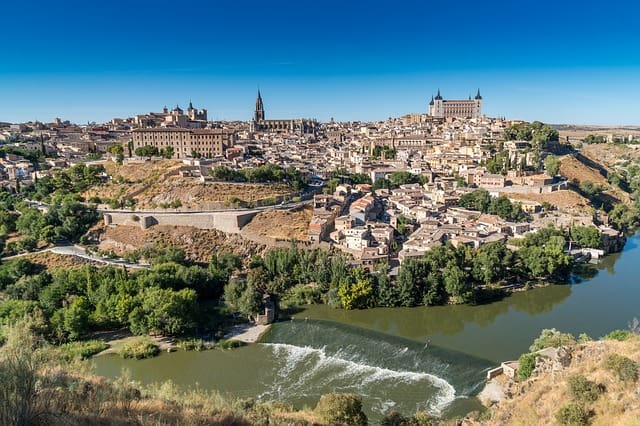
If you want to explore a city steeped with history and culture, go to Toledo! Located around 75 km south of Madrid, Toledo offers visitors a peek of the rich culture of the municipality. Toledo is a significant city in Spain due to the history; its nicknames are testaments to that. One of Toledo’s nicknames is “Imperial City,” as Toledo was once the main seat of Charles V, Holy Roman Empire. Toledo’s other nickname, “City of the Three Cultures,” alludes to the influences of Christians, Muslims, and Jews on the city. Visitors who visit Toledo will see the history in its buildings and in museums as well.
San Miguel Market (Mercado de San Miguel)
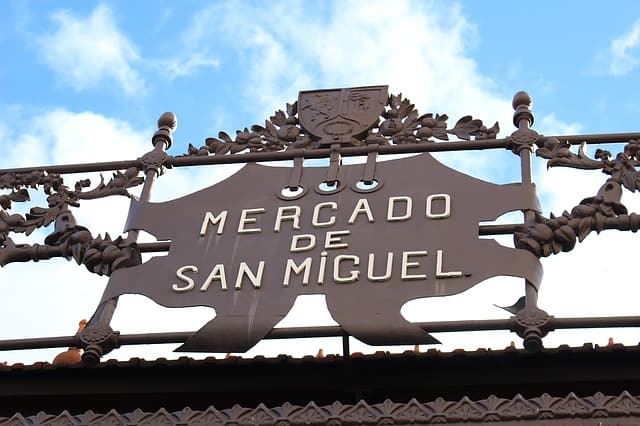
The first food market in Madrid, the San Miguel Market opened in the early 1900s but after undergoing a transformation, reopened in 2012. Visitors, locals, and tourists alike visit the market, which offers food and drinks made with the best of the best ingredients, fresh and delicious. The vendors at San Miguel Market get fresh seafood and jamón ibérico from the city of Galicia every day. They also get regular importation of Mediterranean rice and special cheese from Castile, Asturias, and the Basque Country. At the San Miguel Market, people can try a wide range of tastes and flavor palettes that come from all over Spain.
Golden Triangle of Art
There are three significant museums in Madrid, and all three lie within the Golden Triangle of Art near the Paseo del Prado. Needless to say, each museum stands on a point of this triangle. These museums are the Queen Sofia National Arts Center, the Prado National Museum, and the Thyssen-Bornemisza National Museum.
Queen Sofia National Arts Center
One of the three museums in Madrid is the Queen Sofia National Arts Center, which is famous both for its beautiful exterior and its exhibitions. Specifically, the most famous of the exhibitions are the collections of Spain’s two most influential visual artists Pablo Picasso and Salvador Dali. Other artists represented at the Queen Sofia National arts Center are Joan Miró, Eduardo Chillida, Pablo Gargallo, Julio González, Luis Gordillo, Juan Gris, José Gutiérrez Solana, Lucio Muñoz, Jorge Oteiza, Julio Romero de Torres, Pablo Serrano, Antoni Tàpies, Bacon, Joseph Beuys, Pierre Bonnard, Georges Braque, Alexander Calder, Robert Delaunay, Max Ernst, Lucio Fontana, Sarah Grilo, Damien Hirst, Donald Judd, Vasily Kandinsky, Paul Klee, Yves Klein, Fernand Léger, Jacques Lipchitz, René Magritte, Henry Moore, Bruce Nauman, Gabriel Orozco, Nam June Paik, Man Ray, Diego Rivera, Mark Rothko, Julian Schnabel, Richard Serra, Cindy Sherman, Clyfford Still, Yves Tanguy, and Wolf Vostell.
Prado National Museum
The second museum in the Golden Triangle of Art, and the main one in Madrid, is the Prado National Museum. With its collection based on the Spanish Royal Collection, the Prado National Museum has paintings and other types of work dating from the 12th Century to the 20th Century.
Thyssen-Bornemisza National Museum
Thyssen-Bornemisza National Museum is the third and last museum in the Golden Triangle of Art. Along with the Queen Sofia National Arts Center and the Prado National Museum, the Thyssen-Bornemisza National Museum stands as one of the most important museums in the city. It serves as a complement to the other two museums, filling in the gaps that the other museums lack. With over 1,000 paintings, the Thyssen-Bornemisza National Museum’s collection includes impressionist, expressionist, European and American paintings as well as English and Dutch paintings.
Since the days of the Roman Holy Empire, Spain has been a city steeped with history and culture, and that is evident all over the country. Madrid is a great example of Spain’s majesty. Tourists and locals alike can explore the city and discover the gems that the city had.
